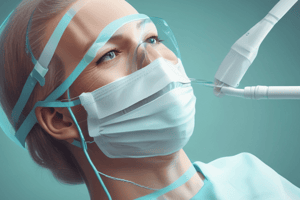Podcast
Questions and Answers
What is the primary purpose of personal protective equipment (PPE) in dental healthcare?
What is the primary purpose of personal protective equipment (PPE) in dental healthcare?
- To protect dental health care personnel from infectious agents (correct)
- To enhance the comfort of dental practitioners during procedures
- To improve patient satisfaction during treatments
- To serve as a fashion statement within the clinic
Under what conditions should protective clothing be changed?
Under what conditions should protective clothing be changed?
- At the end of each month regardless of condition
- When it becomes visibly soiled or after repeated exposure to contaminated aerosols (correct)
- Only when the dental practitioner feels it is necessary
- When transitioning from one patient to another without any visible contamination
How should gloves be utilized in conjunction with hand hygiene?
How should gloves be utilized in conjunction with hand hygiene?
- Gloves eliminate the need for regular handwashing
- Washing hands is only necessary if gloves are visibly damaged
- Hand hygiene must be performed before putting on and after removing gloves (correct)
- Gloves should be worn without prior hand hygiene
What type of protective clothing is recommended for non-surgical dental procedures?
What type of protective clothing is recommended for non-surgical dental procedures?
What is a crucial step to take before wearing gloves during clinical procedures?
What is a crucial step to take before wearing gloves during clinical procedures?
What is a potential consequence of not changing visibly soiled protective clothing promptly?
What is a potential consequence of not changing visibly soiled protective clothing promptly?
Which of the following is NOT a characteristic of disposable gloves?
Which of the following is NOT a characteristic of disposable gloves?
What type of gown is specifically indicated for surgical dental procedures?
What type of gown is specifically indicated for surgical dental procedures?
Flashcards
PPE primary purpose?
PPE primary purpose?
To protect dental healthcare personnel from infectious agents.
When to change protective clothing?
When to change protective clothing?
When visibly soiled or after repeated exposure to contaminated aerosols.
Gloves and hand hygiene?
Gloves and hand hygiene?
Hand hygiene must be performed before putting on and after removing gloves.
Protective clothing for non-surgical procedures?
Protective clothing for non-surgical procedures?
Signup and view all the flashcards
Step before wearing gloves?
Step before wearing gloves?
Signup and view all the flashcards
Consequence of not changing soiled clothing?
Consequence of not changing soiled clothing?
Signup and view all the flashcards
Gown for surgical dental procedures?
Gown for surgical dental procedures?
Signup and view all the flashcards
Study Notes
Personal Protective Equipment (PPE)
- Personal Protective Equipment (PPE) protects dental health care personnel (DHCP) from infectious agents and prevents microorganisms from spreading to patients.
- PPE includes protective clothing, masks, eye protection, and gloves.
Protective Clothing
- Wear protective clothing during patient treatment when splatter or aerosols are likely.
- Protective clothing prevents contamination of street clothes and protects the outside environment.
- Change protective clothing when visibly soiled or after repeated exposure to contaminated aerosols.
- Remove protective clothing before meal breaks or leaving the practice.
- Wear protective clothing over uniform scrubs.
- Short-sleeved gowns are used for non-surgical routine dental care.
- Long-sleeved gowns are used for surgical dental procedures.
Gloves
- Disposable gloves protect DHCP from patient fluids, nailbed infections, and hazardous substances used in dental procedures.
- Hand hygiene should be performed before and after gloving.
- Dental practitioners and support staff must wear gloves for all clinical procedures where exposure to blood, saliva, or other body fluids is possible.
- Gloves protect against exposure to hazardous substances like acids, alkalis, monomers, and solvents.
Facts to Know About Gloves
- Wash hands before putting on sterile gloves.
- Ensure gloves fit properly for comfort during patient care activities.
Studying That Suits You
Use AI to generate personalized quizzes and flashcards to suit your learning preferences.



